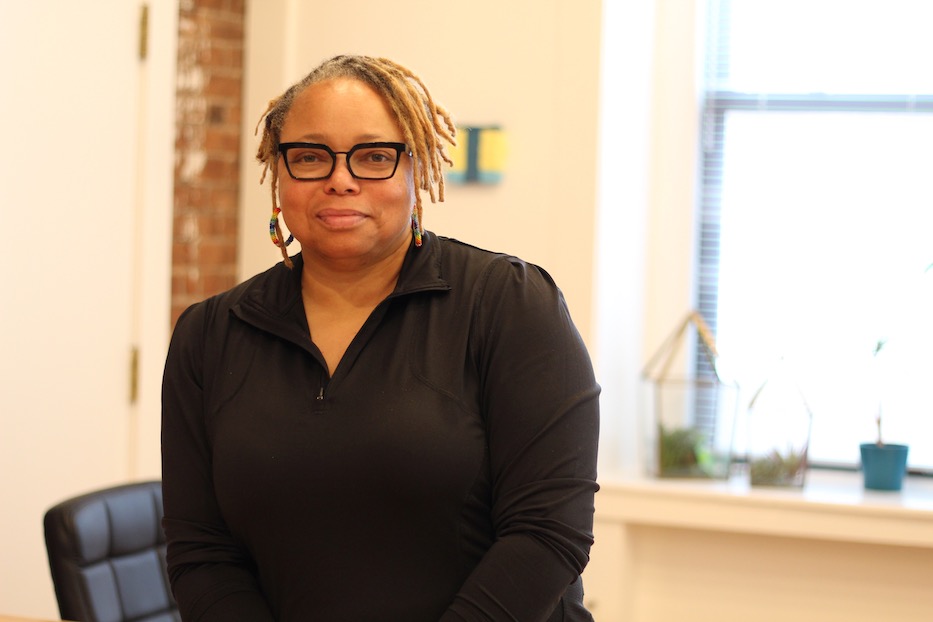
Culture & Community | Downtown | Painting | Photography | Arts & Culture | Visual Arts | Sculpture | Arts & Anti-racism | KNOWN Coworking
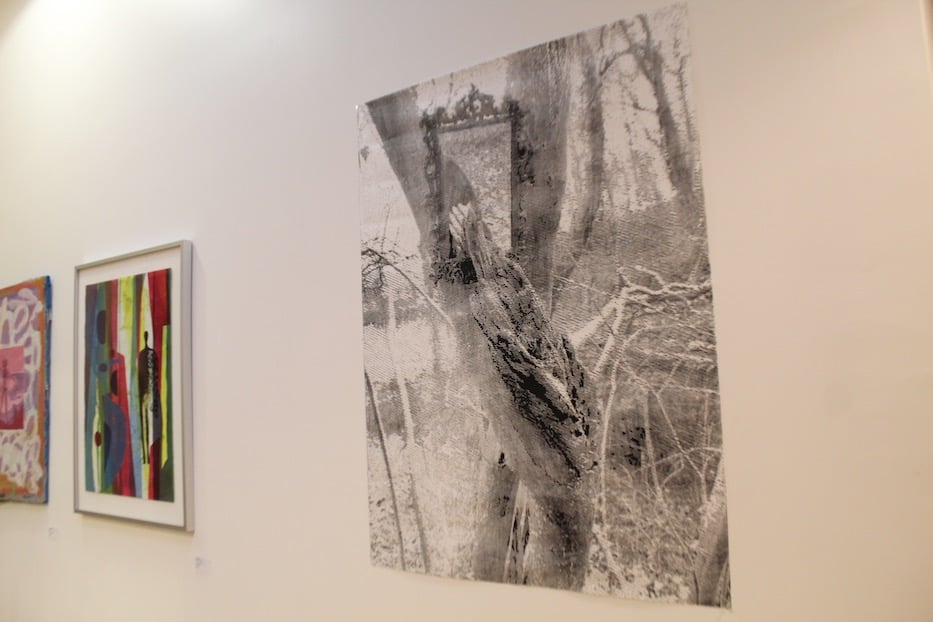
In foreground: Ruby Gonzalez Hernandez’ “A Myth In My Heart, A Stake In Your Hand." Lucy Gellman Photos.
From far away, Ruby Gonzalez Hernandez’ “A Myth In My Heart, A Stake In Your Hand” is a trick mirror, changing every few moments as a viewer moves toward it. One step down the hallway, and it’s a hawk facing towards the ground, plumage thick and its head nowhere in sight. Another, and a carpet of leaves appears underfoot, birch and oak trees rising above them. A third, and the filigreed edges of a mirror appear, a hand and shoulder reflected on its surface.
The work is part of Assemblage, a nine-artist show from Wábi Gallery founder and curator Kim Weston running now through February 2023 at KNOWN Co-Working at 139 Orange St. As it sprawls across the fourth floor of the building, it is a show of firsts, placing a group of artists in conversation with each other—and with the space.
It marks a period of growth for Weston and for Wábi, which this year piloted its first FOCUS fellowship cohort, taught photography classes, and landed a spot in the KNOWNprenuer program that will allow Weston to work toward a brick-and-mortar space on Court Street. Artists, all of whom are also represented by or affiliated with Wábi, include Kwadwo Adae, Oi Fortin, Ruby Gonzalez Hernandez, Noé Jimenez, Susan McCaslin, Susan Clinard, Qiana Mestrich, Daniel Ramos and Weston.
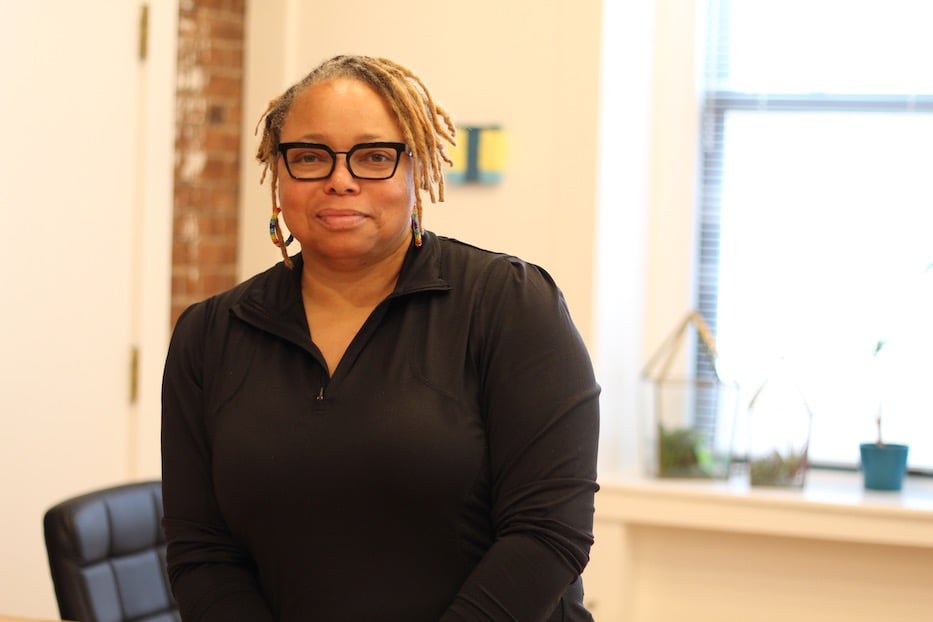
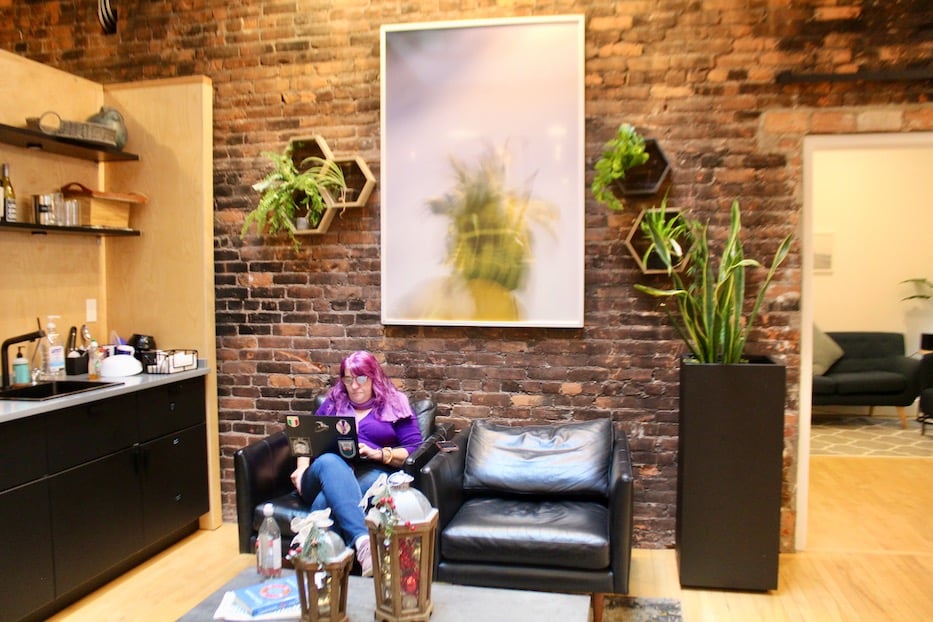
Top: Kim Weston: “I’m trying to create space for these artists. More eyes need to be put upon, shown upon, what we’re doing. More needs to go into making sure artists get paid. ” Bottom: KNOWN's Giulia Gouge with Weston's "Emitting" installed in the space.
“When I came up with the title Assemblage, it was another way of saying ‘Gathering.’ It was another way of saying family,” said Weston, who has included one of her first long exposure photographs in the show. “When I think about the artists I work with, we’re family. We’re a team. I think about how special each of them are in their own right.”
The exhibition was born months ago, when Weston was finishing the 16-week KNOWNprenuer program and knew that Wábi wasn’t going to be ready for an exhibition at 124 Court St. After buying the first-floor space last year, “I ran into roadblocks,” most of them related to funding, she said. Juan Salas-Romer, executive director of KNOWN and president and CEO of NHR Group, suggested that she turn the coworking space into a temporary gallery instead. Weston was thrilled.
“So many of us, we have hundreds of pieces, sometimes thousands of pieces, and they don’t get exhibited,” she said. “I’m trying to create space for these artists. More eyes need to be put upon, shown upon, what we’re doing. More needs to go into making sure artists get paid. ”
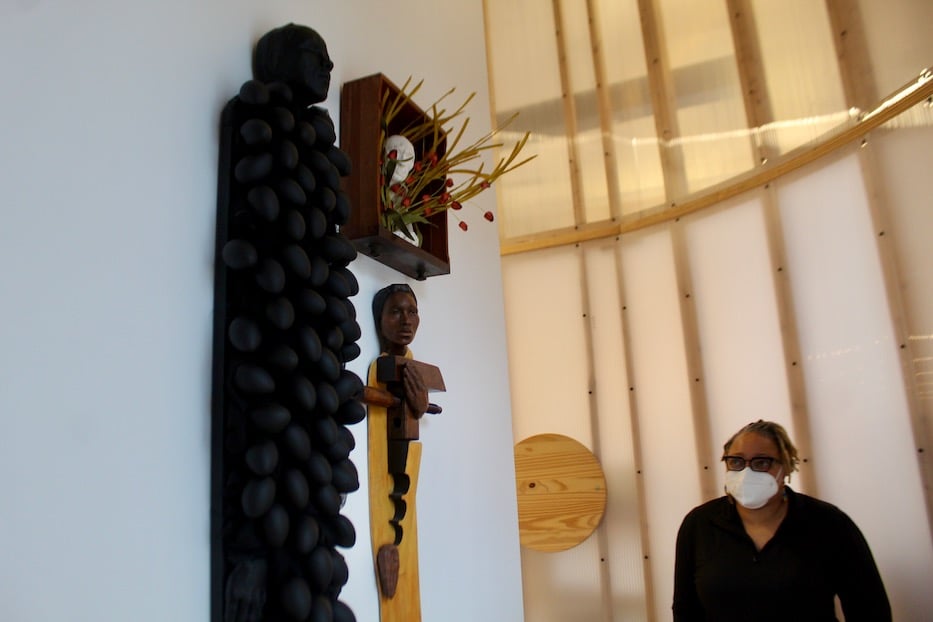
Susan Clinard's ""Vessel," "Gatherer," and "All of Me" behind a corner.
Those words come to life across the Orange Street coworking space, where artwork is now installed above desks, along hallways, in hidden alcoves and beside windows that look out onto downtown New Haven. Between the nine artists, KNOWN has become a haven for painting, sculpture, collage, multiple types of printmaking, and large-scale photography. What makes Assemblage relatively unique is not just the breadth of work, but the quiet hum that runs through it as the pieces find points of connection.
From the moment a person steps off an elevator, they are in the center of this nascent gallery, where each work warrants a second look (or ten). Above a couch, Weston’s 2013 “Emitting” blurs space and time, paying homage to her own history as Black and Native artist. In the work, a pow wow dancer moves through the frame, light bending across the exposure. The dancer turns, and for a moment the viewer can feel their movement. Behind the lens, Weston is there, working the shutter with the heartbeat-like rhythm of the drum.
For Weston, who is Black and Mohawk, it is an early image from her Layers of the Soul series, which explores what it means to live her identity as an artist, a mother, and a Native woman who has had multiple close brushes with death. Almost ten years—and multiple exhibitions and projects—after it was first taken, it also marks a reminder of how much self-discovery she’s done in the last decade. 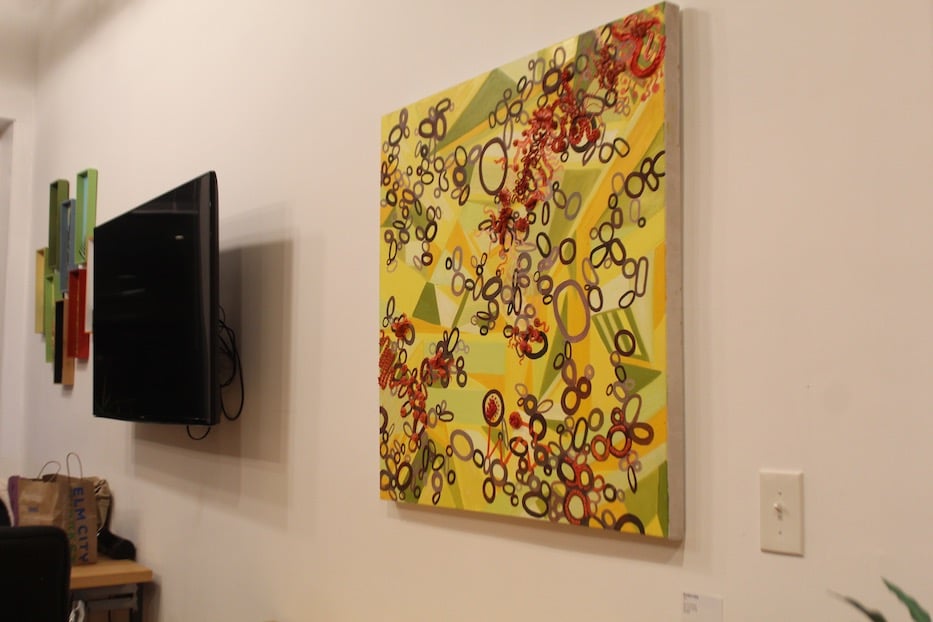
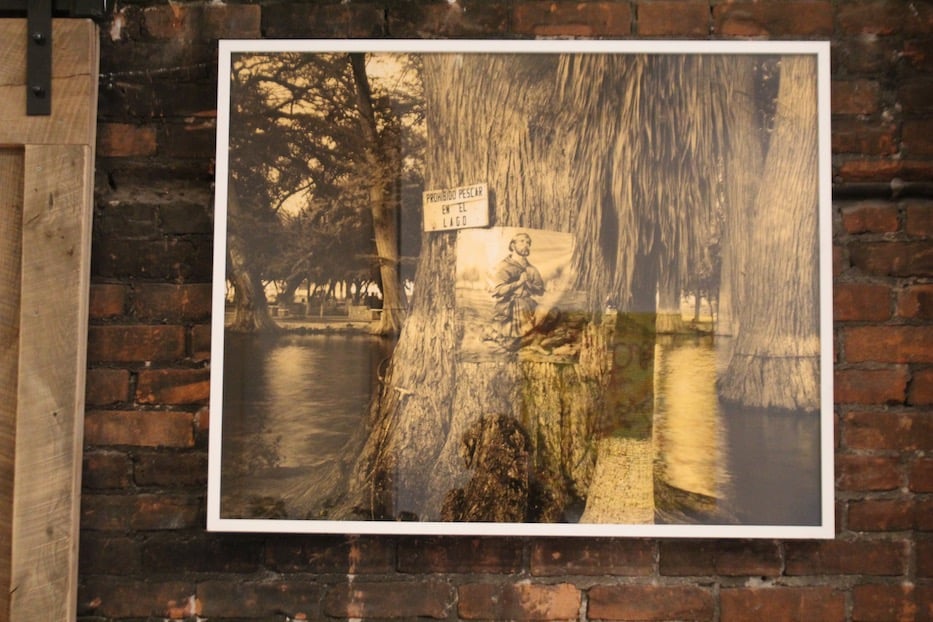
Top: Kwadwo Adae's "#31." Bottom: Daniel Ramos’ 2014 “Monk at the Ojo de Agua" installed in the space.
So too in Daniel Ramos’ 2014 “Monk at the Ojo de Agua,” which hangs just feet away above a coworking desk. A Chicago-raised artist who has worked in New York, Texas, and Los Angeles, Ramos met Weston through NXTHVN, where he was a 2021 fellow. The photograph, taken with a large-format film camera, depicts the Ojo de Agua in Lampazos Naranjo, Nueva Léon, Mexico, his grandmother’s hometown. The space, seemingly empty of people, is an artesian spring surrounded by Montezuma Cypress trees.
In the work, there’s a sense that he has one foot between Chicago and New Haven and another in Lampazos de Naranjo, where he spent summers as a child and has since returned as an artist. On the wide trunk of a Montezuma Cypress, a monk falls to his knees, hands clasped in supplication. Branches hang down, rope-like in the sepia tone. To his left, a sign reminds people that fishing is not allowed anywhere on the premises.
The longer a viewer stands with it, the more details emerge: gnarled tree trunks spreading their roots beneath the water, an overhang that seems straw-like, the sense Ramos is the only person in the world in this place. Here, the meeting of the sacred and the profane is jarring, even funny: the Ojo de Agua feels like one of those thin spaces, where one goes to find and talk to the divine. At the same time, Ramos reminds his viewer that no area is too holy to also include pedestrian reminders that it is a public space.
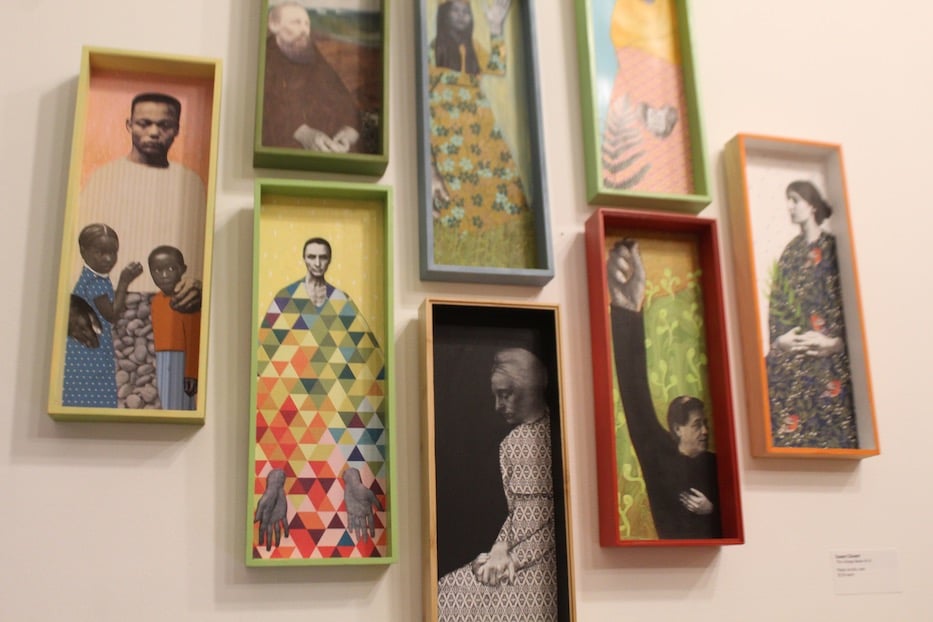
Susan Clinard's Sculpture Boxes in the space.
Throughout, there are invitations for close looking like this, each challenging a viewer to see the world with new eyes. In one room, a print from Qiana Mestrich’s The Black Doll Series finds itself in conversation with Susan Clinard’s multimedia sculpture boxes. An early work from painter and public artist Kwadwo Adae chatters eagerly with three small, sculptural paintings from the artist Noé Jimenez. Around a bend, Susan Mcaslin’s “Singing Bridge” starts a dialogue with the architectural elements just outside the window, where a parking garage beckons.
Weston is a masterful curator, with a keen sense of how works can build on and talk to each other. Down a hallway, Jimenez’ “Untitled,” is soaked in a sea of pinks and purples, at once eye-catching and deeply meditative. Slightly psychedelic—and very much in the vein of portraiture—it gels with Fortin’s “The Sun Also Rises,” a symphony of color and form that seems much calmer, measured. The two play off each other: Jimenez’ work has a frantic quality, but somehow also keeps it copacetic. Fortin, working in monotype, gives the medium the precision it demands. Together, they buzz and crackle with a new energy, as if they are building a friendship.
At an opening last Wednesday, Jimenez said that the piece is inspired by a dream he had after getting back from a recent trip to California. As soon as he woke up, he painted as much of the dream as he could remember, including a series of words that now scroll illegibly across the back of the canvas. “I don’t remember what I wrote,” he said while describing the piece to attendees last week. 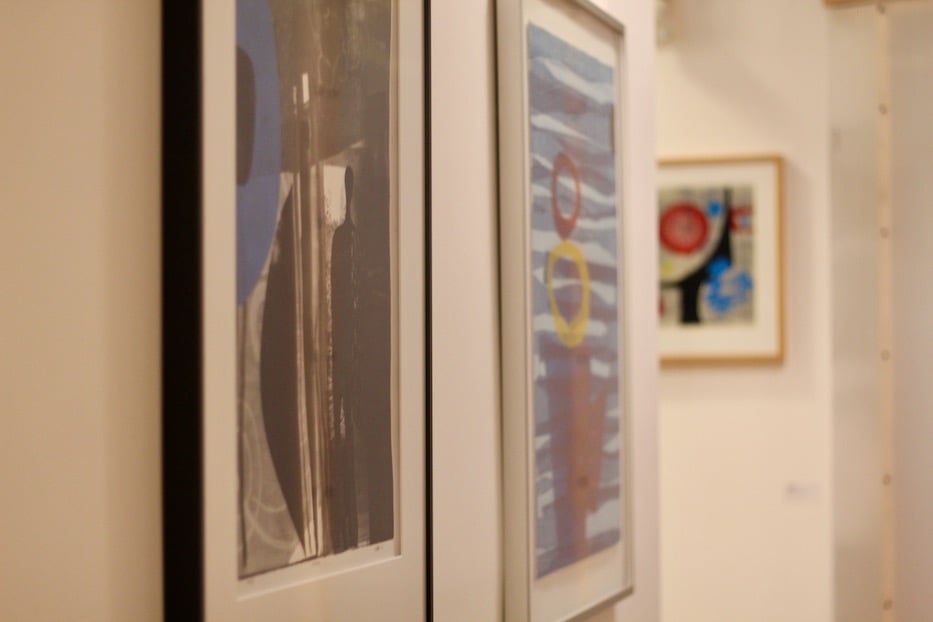
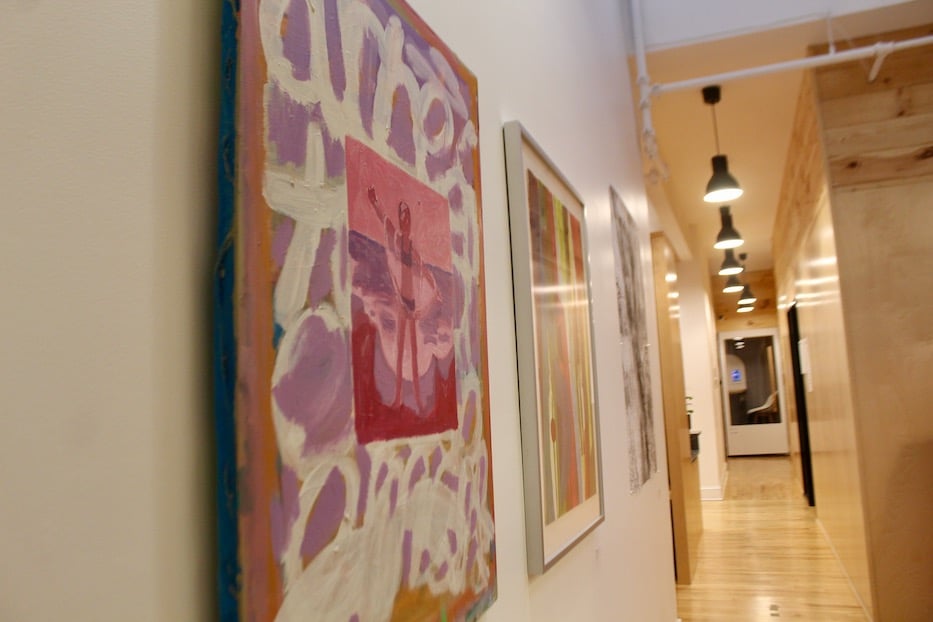
Top: Work by Fortin. Bottom: Noé Jimenez' "Untitled."
It feels like a fitting pendant to “A Myth In My Heart, A Stake In Your Hand,” a large-scale woodcut that is part of Gonzalez Hernandez’ series SubSeven. When Gonzalez Hernandez was working on the series last year, she began with a series of iPhone photos, many of them taken in East Rock Park. “It’s where I go to talk to God and get aligned with myself,” she said, drawing a through line from her work to Ramos’ photograph in a nearby room.
After taking photos, she “destroyed them using code,” creating the deep lines that now slice through the work. Using a CNC machine, she engraved the image on a large piece of plywood, and then printed it by hand. Together, works in the series are part of a healing process, she said—they mark her choice “to leave oppressive systems,” including organized religion. In the work, the mirror allows her to insert herself in the print.
“It was really important for that aspect to be apparent,” she said of making both her labor and her process visible. “I’m moving towards self-portraiture and this is a first step for me.”
Other work is tucked into hallways and corners, such that a viewer must walk through the fourth-floor coworking space to see each piece. Down one hallway, Oi Fortin’s “La Rambla” and “Mindless Chatter” burst into color, so richly layered that the color only translates in person.
There is a wonderful sense of surprise there: Fortin’s printmaking revels in its detail and abstraction, with a delicate touch that is meant for someone to spend time with it (even the paper opens a conversation around substrate as artwork). In “Mindless Chatter,” shapes dance atop each other, as if they have been rendered midway through a delicate balancing act. Just beyond the print, another of Fortin’s work’s beckon, as if it is a signpost drawing the viewer forward.
At an opening last Wednesday, she praised Wábi for creating a space for her to show her work. She looked to the role of joy in both creating and sharing artwork, which Weston has facilitated.
“There's many galleries here where I don’t feel included in the space,” Fortin said. “Wábi has a different approach welcoming artists. I was so grateful that Kim contacted me about doing work together—this wonderful entrepreneur who was willing to take a chance.”
“I truly believe that when you make art that is from your heart and soul, it will permeate in the community,” she added. “I think there’s an energy that comes through when an artist is working from their soul.”
That is perhaps the strongest part of Assemblage: there’s a sense of truth-telling, of intimate histories, of self-discovery and celebration throughout the show.
Weston, who has worked toward running her own space for decades, said she is especially grateful for Salas-Romer and the KNOWNprenuer program, which supports artists and entrepreneurs of color. When she graduated from the program in June of this year, KNOWN provided her with a desk, a year of membership, and a $10,000 line of credit that will help her move toward renovations on 124 Court St.
Last week, Salas-Romer said he is equally grateful for Weston, who is breathing new life into the space with Assemblage. When the show comes down next February, he plans for Weston to stay on as a sort of in-house curator that the KNOWN team also supports. For him, the project is exactly the kind of initiative he imagined when he designed the KNOWNprenuer program. In Wábi’s vision, he said, he can also see his own.
“It’s wonderful!” he said. “I think it’s wonderful on many levels. Having someone like Kim be able to graduate from the program and watching her grow—you really understand the ‘why.’ What drives her. It really connects to the mission of KNOWN. For a coworking space, you want things that are inspirational.”
Assemblage runs at KNOWN Coworking through February 2023. The space, located on the fourth floor of 139 Orange St., is open Monday through Friday from 9 a.m. to 5 p.m. More information is available at its website.

